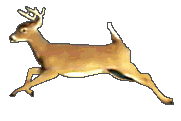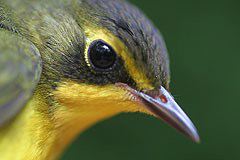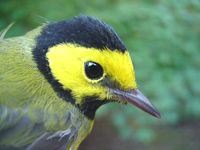|
|
|||
|
THIS WEEK at HILTON POND (Back to Preceding Week; on to Next Week) |
|
DROUGHT AT HILTON POND: Although some parts of the globe have suffered calamitous flooding in the past few months, the South Carolina Piedmont certainly has not been one of them. This time last year we were bemoaning the drought at Hilton Pond Center and wondering if things could be any worse; little did we know that the summer of 2002 would see so little rain that Hilton Pond itself--and its banks--would undergo a drastic change in appearance.
The current "five-year drought" didn't really became noticeable locally until the summer of 2000. By that time, pond water levels had gone down a little (above) and exposed a three-foot band of mud that--by the third week in August last year--was colonized by grasses and composite wildflowers that formed a ribbon of bright green around Hilton Pond. 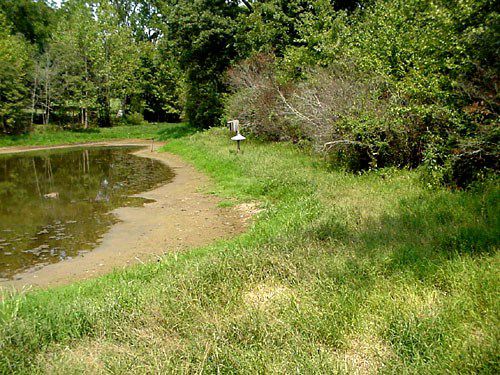 The water level dropped even lower in 2001 so that this year's encroachment of grasses and wildflowers has been even more significant (photo just above). Instead of a yard-wide swath of vegetation, the grasses stretched 15 feet from the pond's pre-drought high-water mark in the late 1990s. We can only anticipate that--without significant precipitation--the new mud exposed in 2002 will be covered with equally enterprising vegetation by this time next year. Despite the much-needed 2.1 inches of rain that fell over two days this week, one-acre Hilton Pond has lost perhaps half its surface area during the summer of 2002. This can't bode well for aquatic organisms that live in the pond, of course, but what is equally alarming is that the water loss is having a devastating effect on shrubs and trees around Hilton Pond. Bad enough there's insufficient water falling from the sky, but the new growth of grasses and wildflowers is sucking up what little water remains in the slightly damp mud. Normally this water is available to roots of various riparian trees and shrubs--including a dense row of 15-foot-tall Hazel Alders that has lined the pond's perimeter for the past decade or so. In photo from 2001 (top of page), The loss of these Hazel Alders, Alnus serrulata, is significant because of what they have provided for a wide variety of birds at Hilton Pond Center: nesting sites for White-eyed Vireos and Northern Cardinals in summer, overnight rest stops for migratory American Redstarts and Scarlet Tanagers in spring and fall, and insect-laden twigs upon which Downy Woodpeckers and Yellow-rumped Warblers foraged in winter. While serving these birds, the alders also provided a visual buffer for us as we walked the trails around the pond. With the alders gone, the wide-open view will make it much harder to stalk, observe, and photograph Great Blue Herons, River Otters, and Painted Turtles that have called Hilton Pond home in previous seasons. Perhaps a few of the millions of seeds produced by the alders through the years will lie dormant in the soil and germinate if normal water levels ever return.
For last year's photo essay about possible causes for our dry spell, see Drought at Hilton Pond: The King's Pinnacle Effect? Comments or questions about this week's installment? NOTE: Be sure to scroll down for an account of all birds banded or recaptured during the week, as well as some other interesting nature notes. "This Week at Hilton Pond" is written & photographed You may wish to consult our Index of all nature topics covered since February 2000. You can also use the on-line Search Engine at the bottom of this page. For a free, non-fattening, on-line subscription to "This Week at Hilton Pond," just send us an E-mail with SUBSCRIBE in the Subject line. Please be sure to configure your spam filter to accept E-mails from hiltonpond.org. |


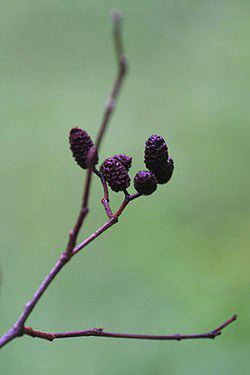 these water-loving alders are all still green, but this week's photos (just above and at right) show leafless branches bearing withered cones that indicate the shrubs are dying or already dead.
these water-loving alders are all still green, but this week's photos (just above and at right) show leafless branches bearing withered cones that indicate the shrubs are dying or already dead.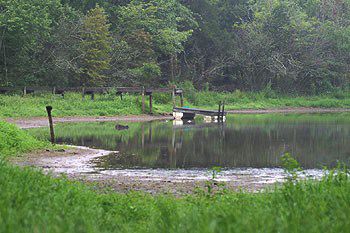 To be honest, we have mixed feelings about these drastic changes all around Hilton Pond. From a scientific standpoint, it's fascinating to see how vegetation and wildlife can be affected so severely by the lack of rainwater, but we're still somewhat disappointed that diverse habitats we've nurtured and tended for the past two decades are slipping away. We realize, of course, that ponds--like old fields and woodlands--are affected by natural succession and that it's just a matter of time before every small body of water in the Piedmont gets smaller, becomes a wetland, and finally turns into a meadow. We're just having trouble coming grips to the fact that Hilton Pond may need to be renamed Hilton Bog a lot sooner than we had anticipated.
To be honest, we have mixed feelings about these drastic changes all around Hilton Pond. From a scientific standpoint, it's fascinating to see how vegetation and wildlife can be affected so severely by the lack of rainwater, but we're still somewhat disappointed that diverse habitats we've nurtured and tended for the past two decades are slipping away. We realize, of course, that ponds--like old fields and woodlands--are affected by natural succession and that it's just a matter of time before every small body of water in the Piedmont gets smaller, becomes a wetland, and finally turns into a meadow. We're just having trouble coming grips to the fact that Hilton Pond may need to be renamed Hilton Bog a lot sooner than we had anticipated.